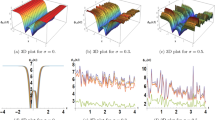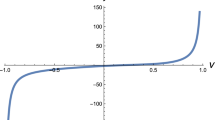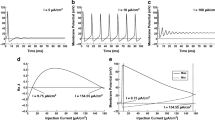Abstract
A qualitative analysis of the Hodgkin-Huxley model (Hodgkin and Huxley 1952), which closely mimics the ionic processes at a real nerve membrane, is performed by means of a singular perturbation theory. This was achieved by introducing a perturbation parameter that, if decreased, “speeds up” the fast variables of the Hodgkin-Huxley equations (membrane potential and sodium activation), whereas it does not affect the slow variables (sodium inactivation and potassium activation). In the most extreme case, if the perturbation parameter is set to zero, the original four-dimensional system “degenerates” to a system with only two differential equations. This degenerate system is easier to analyze and much more intuitive than the original Hodgkin-Huxley equations. It shows, like the original model, an infinite train of action potentials if stimulated by an input current in a suitable range. Additionally, explanations for the increased sensitivity to depolarizing current steps that precedes an action potential can be found by analysis of the degenerate system. Using the theory of Mishchenko and Rozov (1980) it is shown that the degenerate system does not only represent a simplification of the original Hodgkin-Huxley equations but also gives a valid approximation of the original model at least for stimulating currents that are constant within a suitable range.
Similar content being viewed by others
References
Awiszus, F.: The adaptation ability of neuronal models subject to a current step stimulus. Biol. Cybern. 59, 295–302 (1988)
Carpenter, G. A.: Bursting phenomena in excitable membranes. SIAM J. Appl. Math. 36, 334–372 (1979)
Cole, K. S., Antosiewicz, H. A., Rabinowitz, P.: Automatic computation of nerve excitation. J. Soc. Indust. Appl. Math. 3, 153–172 (1955)
Cooley, J., Dodge, F., Cohen, H.: Digital computer solutions for excitable membrane models. J. Cell. Comp. Physiol. 66 [Suppl. No. 2], 99–110 (1965)
Cronin, J.: Mathematical aspects of Hodgkin-Huxley neural theory. Cambridge Studies in Mathematical Biology. Cambridge: Cambridge University Press 1987
Fitzhugh, R.: Thresholds and plateaus in the Hodgkin-Huxley nerve equations. J. Gen. Physiol. 43, 867–896 (1960)
Fitzhugh, R.: Impulses and physiological states in models of nerve membrane. Biophys. J. 1, 445–466 (1961)
Fitzhugh R.: Mathematical models of excitation and propagation in nerve. In: Schwan, H. P. (ed.) Biological engineering. New York: McGraw-Hill 1969
Guttman, R., Lewis, S., Rinzel, J.: Control of repetitive firing in squid axon membrane as a model for a neuroneoscillator. J. Physiol. 305, 377–395 (1980)
Hasard, B.: Bifurcation of periodic solutions of the Hodgkin-Huxley model for the squid giant axon. J. Theor. Biol. 71, 401–420 (1978)
Hindmarsh, J. L., Rose, R. M.: A model of the nerve impulse using two first-order differential equations. Nature 296, 162–164 (1982)
Hodgkin, A. L., Huxley, A. F.: A quantitative description of membrane current and its application to conduction and excitation in nerve. J. Physiol. 117, 500–554 (1952)
Holden, A. V., Yoda, M.: Ionic channel density of excitable membranes can act as a bifurcation parameter. Biol. Cybern. 42, 29–38 (1981)
Meves, H.: Hodgkin-Huxley: Thirty years after. Curr. Top. Membr. Transp. 22, 279–329 (1984)
Mishchenko, E. F., Rozov, N. Kh.: Differential equations with small parameters and relaxation oscillations. New York: Plenum Press 1980
Nagumo, J. S., Arimoto, S., Yoshizawa, S.: An active pulse transmission line simulating nerve axon. Proc. IRE 50, 2061–2070 (1962)
Nemoto, I., Miyazaki, S., Saito, M., Utsunomiya, T.: Behavior of solutions of the Hodgkin-Huxley equations and its relation to properties of mechanoreceptors. Biophys. J. 15, 469–479 (1975)
Noble, D.: Applications of Hodgkin-Huxley equations to excitable tissues. Physiol. Rev. 46, 1–50 (1966)
Plant, R. E.: The geometry of the Hodgkin-Huxley model. Comp. Progs. Biomed. 6, 85–91 (1976)
Rinzel, J. Miller, R.: Numerical calculation of stable and unstable periodic solutions to the Hodgkin-Huxley equations. Math. Biosci. 49, 27–59 (1980)
Schwindt, P. C., Crill, W. E.: Factors influencing motoneuron rhythmic firing: results from a voltage-clamp study. J. Neurophysiol. 48, 875–890 (1982)
Sibuya, Y.: On perturbations of discontinuous solutions of ordinary differential equations. Natur. Sci. Rep. Ochanimizu Univ. 11, 1–18 (1960)
Author information
Authors and Affiliations
Rights and permissions
About this article
Cite this article
Awiszus, F., Dehnhardt, J. & Funke, T. The singularly perturbed Hodgkin-Huxley equations as a tool for the analysis of repetitive nerve activity. J. Math. Biol. 28, 177–195 (1990). https://doi.org/10.1007/BF00163144
Received:
Revised:
Issue Date:
DOI: https://doi.org/10.1007/BF00163144




